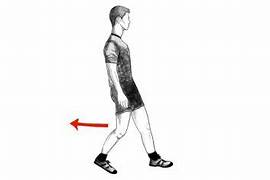
Why You Should Be Walking Backward (And How to Level It Up)
Walking backward isn’t just a novelty—it’s a powerful movement technique with science-backed benefits for strength, joint health, balance, and brain function. From reducing knee pain to improving coordination and burning more calories, retro walking challenges your body and mind in ways forward walking doesn’t. Whether you're recovering from injury or looking to enhance performance, this simple, equipment-free practice can deliver surprising results for people of all fitness levels.
💪 Fitness Guru
47 min read · 21, Jun 2025

Introduction
When was the last time you walked backward? For most people, the answer is probably during a childhood game or by accident. But what if backward walking—also known as retro walking—wasn't just a playful or rare movement, but a transformative fitness and rehabilitation tool? Recent research, along with anecdotal evidence from athletes and physical therapists, points to a wide range of benefits tied to this counterintuitive exercise. Whether you're looking to improve your athletic performance, prevent injury, or just add some spice to your walking routine, it's time to consider taking a few steps in reverse.
The Science Behind Walking Backward
Walking backward engages muscles, joints, and neural pathways in a fundamentally different way than forward walking. Here’s what happens:
- Increased muscular activation: Retro walking places more emphasis on the quadriceps, glutes, and calves compared to forward walking, which relies more on the hamstrings.
- Reduced joint loading: Studies show that walking backward can reduce the compressive forces on the knee joint, making it beneficial for people with patellofemoral pain or early osteoarthritis.
- Enhanced proprioception and coordination: Because walking backward demands more focus and balance, it stimulates parts of the brain responsible for motor coordination and spatial awareness.
- Cognitive stimulation: A surprising benefit of backward walking is the mental engagement it requires. It challenges the brain in new ways, improving memory, reflexes, and neuroplasticity.
Key Benefits of Walking Backward
1. Stronger Legs and Core
Backward walking recruits and strengthens the muscles that are underutilized in forward walking. This includes the tibialis anterior (shin muscle), which is critical for foot dorsiflexion, as well as the vastus medialis (a part of the quadriceps that supports the knee).
2. Better Knee Health
For those with joint pain, backward walking can relieve symptoms by reducing shear force on the knees. It also increases knee flexion strength and improves joint stability without high impact.
3. Improved Balance and Stability
Retro walking forces the body to rely on proprioception (the body’s sense of its position in space) rather than vision. This enhances balance and reaction time, especially useful for older adults or those recovering from injury.
4. Caloric Burn and Cardiovascular Boost
You burn up to 30% more calories walking backward at the same pace compared to forward walking. It elevates heart rate quickly, making it a useful form of low-impact cardio.
5. Enhanced Athletic Performance
Athletes use backward walking and running to train for multidirectional movement, improve agility, and reduce injury risks. It’s common in rehabilitation for ACL injuries or for sports like football and basketball.
6. Mind-Body Coordination
Retro walking stimulates the cerebellum and the prefrontal cortex, improving brain-body communication. It also enhances memory recall and decision-making under pressure.
How to Start Walking Backward Safely
If you’ve never tried it before, walking backward can feel disorienting. Start with these safety tips:
- Choose a Safe Environment: Begin in a flat, obstacle-free area such as a track, gym, or grassy field.
- Use Visual Cues: Use mirrors or a partner to help guide your steps initially.
- Take Small Steps: Begin with slow, controlled movements. Focus on posture and core engagement.
- Engage Your Arms: Keep your arms slightly out or moving naturally to help with balance.
- Limit Initial Sessions: Start with 5–10 minutes and gradually increase as your body adapts.
How to Level It Up
Once you’re comfortable with basic retro walking, here are advanced ways to challenge your body further:
1. Backward Walking on Inclines
Walking backward uphill increases the activation of your glutes and calves significantly, offering a greater strength challenge.
2. Add Resistance
Use resistance bands around your waist, ankle weights, or push a sled backward for a powerful lower-body workout.
3. Incorporate Arm Movements
Add light dumbbells or resistance tubing to engage your upper body as you move in reverse.
4. Backward Jogging or Running
Once your balance and coordination improve, you can progress to retro jogging, which improves agility and anaerobic capacity.
5. Balance Tools
Try walking backward on a treadmill at a slow speed or on a narrow path like a balance beam to really push your coordination.
6. Cognitive Challenges
Combine backward walking with memory games, counting sequences, or responding to verbal cues to sharpen mental focus.
Walking Backward in Rehab and Therapy
Physical therapists frequently use backward walking for patients recovering from:
- Knee surgeries (especially ACL repairs)
- Stroke or neurological disorders
- Gait retraining after injury
- Lower limb amputations
It helps retrain the brain and body for controlled, safe movement patterns while strengthening muscles without excessive impact.
Common Mistakes to Avoid
- Looking over your shoulder constantly: This throws off posture and balance. Use mirrors or trust your spatial awareness.
- Over-striding: Keep steps short to maintain control.
- Wearing inappropriate shoes: Use flat, grippy shoes to maintain good contact with the ground.
- Rushing the progression: Build your ability over weeks, not days. Listen to your body.
Incorporating Backward Walking into Your Routine
- Warm-up or cool-down: Add 5 minutes of backward walking to each end of your workout.
- Standalone session: 15–20 minutes of backward walking is a great cardiovascular and muscular workout.
- Intervals: Combine 1 minute of backward walking with 2 minutes of forward walking for a hybrid walking workout.
Walking backward, often seen as quirky or unusual, is actually an underrated yet powerful form of movement that offers remarkable benefits for physical and mental health, athletic performance, and rehabilitation. Unlike forward walking, which becomes second nature and requires little mental engagement, backward walking—also called retro walking—activates a broader range of muscles, enhances coordination, and challenges the brain in stimulating ways. This movement emphasizes the quadriceps, calves, glutes, and tibialis anterior (the muscle along the shin), helping to strengthen these areas while improving joint stability and mobility. Interestingly, studies have shown that retro walking reduces the compressive force on the knees, making it especially helpful for those suffering from patellofemoral pain, early-stage arthritis, or post-surgery rehabilitation. Athletes use it as a tool to improve agility, neuromuscular control, and multidirectional strength, which is crucial for sports like football, basketball, or martial arts where rapid changes in direction are required. Beyond the physical gains, walking backward also provides cognitive benefits: it improves proprioception (the body's ability to sense its position), boosts mental clarity, and even enhances memory and reaction time by engaging areas of the brain like the cerebellum and prefrontal cortex. Because it’s unfamiliar to most, walking backward demands more attention and body awareness, turning even a few steps into a full-body, brain-engaging workout. Starting out, beginners should ensure safety by choosing a flat, open space free of obstacles, wearing supportive shoes, and beginning with small, controlled steps. Using mirrors, walls, or a workout partner for orientation can help reduce the risk of tripping or falling, especially in the early stages. Once mastered, the activity can be leveled up through several progressive variations—such as backward incline walking, adding resistance via bands or sleds, combining backward walking with upper-body movements like dumbbell curls, or transitioning into backward jogging and sprinting for added cardiovascular and strength benefits. Even more advanced options include backward walking on a treadmill, on unstable surfaces like balance beams, or while simultaneously performing cognitive challenges like memory games, which further sharpen coordination and mental acuity. In physical therapy settings, backward walking is used widely to rehabilitate ACL injuries, stroke-related gait issues, and post-operative leg weakness, since it builds muscular strength while minimizing joint stress. The key to success is patience and consistency—starting with short sessions of 5 to 10 minutes, two to three times per week, and slowly increasing the duration as confidence and ability grow. Common mistakes to avoid include over-striding (which reduces balance), constantly looking over the shoulder (which disrupts posture), and progressing too quickly without proper adaptation. Instead, keeping steps short, engaging the core, and maintaining good posture are critical to preventing injury and maximizing the benefits. Even in the context of a busy schedule, backward walking can be seamlessly incorporated into daily routines—during warm-ups, cool-downs, or as a standalone workout. In fact, because retro walking burns about 30% more calories than forward walking at the same speed, it offers a more efficient cardiovascular boost in less time. Older adults can benefit significantly as well, since the enhanced balance and proprioception may help prevent falls and maintain mobility. The mental focus required also makes it a great “moving meditation,” helping to relieve stress and improve mindfulness. For those seeking weight loss, retro walking adds variety and intensity to walking routines without the need for high-impact moves or equipment. Whether on a trail, treadmill, track, or just around the house, the key is consistency and variety—adding intervals of backward walking to a traditional walking session, or even challenging friends and family to try it together. From a neurological standpoint, backward movement seems to activate different motor planning circuits in the brain, improving executive function and possibly even supporting long-term cognitive health, especially when combined with other coordination drills. Trainers and rehab specialists often recommend pairing retro walking with exercises like lunges, squats, or hip mobility drills for a complete lower-body strengthening session that’s functional and joint-friendly. One of the most appealing things about walking backward is its simplicity—it requires no gym membership, no special equipment, and no expensive gear, just a willingness to go against the flow. In summary, walking backward is far more than a physical curiosity—it’s a dynamic, science-backed way to improve your body and brain. From boosting muscular engagement, improving joint health, increasing caloric burn, and enhancing neurological pathways, to supporting injury recovery and sports conditioning, the benefits are diverse and far-reaching. If done with consistency and care, backward walking can transform your physical performance and mental sharpness alike. All you need to do is step back—literally—and embrace this surprisingly powerful movement. To conclude, backward walking challenges the norm but rewards those who try it with improved strength, sharper balance, better posture, and a more resilient mind-body connection. In a world where forward progress is prized, sometimes the best move is the one taken in reverse.
Walking backward, often dismissed as merely quirky or reserved for childhood play, is actually a surprisingly effective and scientifically backed movement practice that engages the body and brain in unique ways, offering a wide range of health, fitness, and rehabilitative benefits that many people overlook in their daily routines; when compared to forward walking, which relies heavily on automatic movement patterns and passive coordination, backward walking—also known as retro walking—requires conscious engagement, increased muscular activation, and heightened spatial awareness, thus stimulating the brain’s motor and sensory systems to a much greater degree, particularly the cerebellum and prefrontal cortex which are responsible for balance, coordination, and executive function; this mental stimulation, when paired with the physical demands of retro walking, leads to improvements in cognitive processing, memory, reaction speed, and neuromuscular control, making it particularly valuable not just for fitness enthusiasts but also for older adults, athletes, and individuals recovering from injury; physiologically, walking backward places a greater load on the quadriceps, glutes, calves, and anterior tibialis (shin muscle), which are often underutilized in forward walking, thereby strengthening the front of the legs and promoting better muscular balance in the lower body while also improving joint stability, especially around the knees, since studies have shown that backward walking reduces patellofemoral joint stress and compression, making it an ideal exercise for those dealing with knee pain, osteoarthritis, or recovering from knee surgeries such as ACL repairs; furthermore, retro walking enhances balance and proprioception because it removes visual guidance from the equation, forcing the body to rely on inner senses and coordination systems that often deteriorate with age or disuse, and by cultivating this internal feedback loop, individuals improve their stability, spatial orientation, and gait symmetry, all of which contribute to fall prevention and overall mobility; interestingly, walking backward is also a highly effective cardiovascular workout—it increases heart rate more rapidly than forward walking, and research indicates it burns up to 30% more calories at the same pace, making it an efficient form of low-impact cardio that promotes fat loss, endurance, and aerobic conditioning without the pounding stress of jogging or jumping; to begin safely, individuals should start in open, obstacle-free areas such as parks, empty gymnasiums, or tracks, using mirrors or a workout partner for feedback while keeping steps short, posture upright, and arms engaged for balance—initial sessions should be limited to 5–10 minutes to allow muscles, joints, and the nervous system to adapt, and once confidence builds, there are several ways to level up the practice, such as walking backward uphill to increase muscular demand, adding resistance bands or weighted sleds for power and strength training, transitioning into backward jogging or sprinting for agility and anaerobic conditioning, or incorporating tools like treadmills and balance beams to further challenge proprioceptive control; some fitness enthusiasts even take things a step further by combining backward walking with cognitive drills, such as solving math problems, reacting to verbal cues, or performing dual tasks, which enhances brain plasticity and functional multitasking—a benefit especially relevant for aging populations or those undergoing neurological rehabilitation; in the clinical world, physical therapists have long used retro walking as a foundational tool in rehabilitation protocols for stroke survivors, patients with spinal cord injuries, amputees, and individuals recovering from orthopedic surgeries, as it allows safe strengthening and retraining of motor patterns without excessive joint loading or pain, and athletes in sports requiring explosive direction changes—like basketball, football, or tennis—use backward walking and running to improve backward acceleration, deceleration control, and multidirectional strength, which are essential for peak performance and injury prevention; despite its benefits, several common mistakes must be avoided, such as over-striding (which compromises balance), leaning too far back or forward (which affects posture and alignment), or constantly turning the head to look behind (which can strain the neck and disrupt rhythm)—instead, focus should be placed on maintaining a centered torso, engaging the core, and using controlled, deliberate movements to develop rhythm and confidence over time; once integrated into a routine, retro walking can be used in various ways: as a warm-up to activate key muscles, a standalone workout lasting 15–20 minutes for cardiovascular health, or as part of a larger circuit to promote strength and endurance, and because it requires no equipment, no gym membership, and very little space, it can easily be adapted to home environments, parks, or even long hallways; in fact, older adults who incorporate backward walking into their weekly regimen may notice improvements in balance, stride length, and fall resistance, while younger populations can benefit from the muscular engagement and fat-burning intensity, making it a universally accessible practice that challenges conventional approaches to fitness while offering measurable results; moreover, backward walking serves as a powerful metaphor for breaking habits and thinking differently—since walking backward is unfamiliar and awkward at first, it encourages mindfulness, present-moment awareness, and the development of new neural connections that promote adaptability in both physical and mental domains; over time, with consistent practice, retro walking not only becomes more natural but also builds a level of proprioceptive and muscular competence that carries over into daily activities, athletic performance, and overall body awareness, helping to prevent injuries, relieve chronic pain, and keep the body functioning efficiently across all ages and fitness levels; ultimately, the value of walking backward lies not in its novelty, but in its comprehensive engagement of body and mind, offering a low-barrier, high-reward method of training that’s rooted in science and applicable to real life, so whether you're a competitive athlete, an aging adult hoping to preserve independence, or simply someone looking to explore new dimensions of health and wellness, turning around and walking in reverse might just be the most forward-thinking move you can make—because sometimes, the best way to move ahead is to take a few steps back.
Conclusion
Walking backward may seem unusual, but it's backed by science and used by athletes, therapists, and fitness professionals to improve health, strength, and performance. From reducing knee pain to boosting brain function, the benefits are diverse and compelling. Whether you're looking to spice up your routine, recover from an injury, or gain a performance edge, turning around might be exactly what you need.
Incorporating backward walking into your routine doesn’t require equipment or a gym. All it takes is some space, awareness, and a willingness to go against the grain—literally. Over time, this simple change in direction can deliver big results.
Q&A Section
Q1 :- (What muscles are primarily used when walking backward?)
Ans:- Walking backward targets the quadriceps, glutes, calves, and shin muscles like the tibialis anterior more intensely than forward walking.
Q2 :- (Is walking backward good for knee pain?)
Ans:- Yes, backward walking reduces pressure on the knees and strengthens surrounding muscles, making it beneficial for people with knee pain or recovering from surgery.
Q3 :- (Can backward walking improve balance?)
Ans:- Absolutely. Because it challenges your proprioception and coordination, it significantly enhances balance and body awareness.
Q4 :- (How many calories does backward walking burn compared to forward walking?)
Ans:- It can burn up to 30% more calories than forward walking at the same pace due to the added muscular demand and coordination.
Q5 :- (Can elderly people do backward walking?)
Ans:- Yes, but they should start slowly in a controlled environment, possibly with assistance or supervision, to prevent falls.
Similar Articles
Find more relatable content in similar Articles

Training with Altitude Masks: Does It Really Mimic Mountain ..
Exploring Altitude Masks: Sepa.. Read More

The Skin-Food Connection: What to Eat for Acne-Free, Radiant..
What you eat directly shapes .. Read More

Parenting and Fitness: Turning Playtime Into Workouts...
Discover how parents can seaml.. Read More

Anti-Aging on a Plate: Foods That Keep Your Skin Youthful an..
What you eat reflects on your.. Read More
© 2024 Copyrights by rFitness. All Rights Reserved.